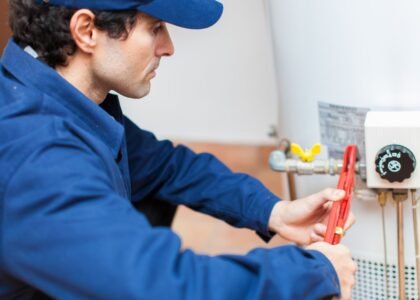When your water heater starts to fail, it can bring your daily routine to a screeching halt. Few household issues are as disruptive as a lack of hot water. Whether you’re dealing with lukewarm showers, strange noises, or a leaking tank, it’s important to understand what goes into professional water heater repair in Monterey.
This post will walk you through what to expect when scheduling a repair, common problems technicians find, how to prepare for service, and what you can do to extend the life of your unit.
Understanding Why Water Heaters Fail
Every water heater, no matter how reliable, will develop issues over time. Some of the most common causes include:
- Sediment buildup from hard water, which reduces heating efficiency and can cause overheating or loud rumbling noises.
- Corrosion and rust, especially in older units or those with a depleted anode rod.
- Faulty heating elements or thermostats, leading to inconsistent or no hot water.
- Leaking valves, fittings, or tank seams that may start small and worsen over time.
- Poor venting or gas control issues in gas-powered systems.
- General wear and age after years of daily use.
Spotting early warning signs can prevent a full breakdown. Listen for strange sounds, check for visible rust or leaks, and note changes in water temperature or color.
The Water Heater Repair Process
If you’ve never had your water heater repaired before, here’s what typically happens when you call a professional:
- Initial inspection and diagnosis – The technician will shut off power or gas to your unit for safety and perform a complete visual and functional inspection. They’ll check the pressure relief valve, drain valve, thermostat, heating elements, gas controls, and plumbing connections.
- Identifying the problem – Using specialized tools, the technician determines which components have failed. Sometimes, the issue is simple, like a thermostat or valve replacement. In other cases, corrosion or internal leaks may point to more serious damage.
- Repair recommendations – You’ll be informed of what needs to be fixed, how long it should take, and the estimated cost. Technicians will explain your options clearly so you can make an informed choice before any work begins.
- Performing the repair – Once approved, the plumber will carry out the necessary repairs, which could include:
- Replacing heating elements, thermostats, or valves
- Repairing minor leaks in fittings
- Flushing sediment from the tank
- Replacing a worn-out anode rod
- Adjusting or cleaning gas burners
- Testing and final inspection – After repairs are complete, the technician restores power or gas, fills the tank, and ensures the water reaches the correct temperature. They’ll also check for leaks and verify that the heater operates quietly and efficiently.
How Much Does Water Heater Repair Cost?
Repair costs depend on several factors, such as:
- The part or system that’s malfunctioning
- Whether it’s a gas or electric heater
- The age and accessibility of your unit
- Labor time and complexity of the repair
A professional will assess your situation and explain whether repair is the most cost-effective option. Sometimes, if the unit is old or has multiple issues, a full replacement might be more practical—but many repairs are simple and affordable when handled promptly.
How to Prepare for a Water Heater Service Visit
Before your technician arrives, a little preparation can make the visit go smoothly:
- Clear the area around the water heater so there’s room to work.
- Turn off the power or gas supply if you know how to do so safely.
- Move any stored items away from the unit.
- Inform the technician of any recent changes or noises you’ve noticed.
These small steps help the plumber work efficiently and safely.
Simple Maintenance Tips After a Repair
After your heater has been repaired, you’ll want to keep it running efficiently. Regular upkeep helps prevent future issues:
- Flush the tank at least once a year to remove sediment.
- Check and replace the anode rod as needed to prevent corrosion.
- Inspect valves and fittings periodically for drips or rust.
- Keep the temperature set between 120°F and 125°F.
- Watch for early warning signs like fluctuating water temperatures or noises.
Preventive maintenance is the best way to avoid expensive repairs later.
When to Consider a Replacement Instead of Repair
Even with the best care, all water heaters eventually reach the end of their lifespan. Consider replacement if:
- Your heater is 10–12 years old (or older).
- You’ve had multiple repairs in a short period.
- The tank itself is leaking or corroded.
- Your utility bills are climbing due to inefficiency.
- You need more hot water than your current tank can handle.
If replacement becomes necessary, a qualified plumber can recommend the best options for your home and budget.
Final Thoughts
Water heater problems can be frustrating, but with professional help, they’re rarely catastrophic. By understanding the process and taking simple maintenance steps, you can restore reliable hot water and prevent future issues.
If you’re currently experiencing water heater trouble, learn more about the process on our Water Heater Repair in Monterey – What You Need to Know page, or get in touch through our contact page to schedule a service call today.



